Dave Foster (Advertising ’05) is a social innovation designer, focused on creating solutions for social and environmental benefit based on deep understanding of issues and communities in need. His expertise is in social enterprise, sustainability and, increasingly, development and appropriate technologies. He is the founder and editor of BoP Designer, a website and blog dedicated to “solutions and social innovations at the ‘base of the pyramid’”. His personal portfolio can be found at davefoster.info. Dave currently lives in Dubai, UAE.
Design for Development and the Base of the Pyramid
By Dave Foster
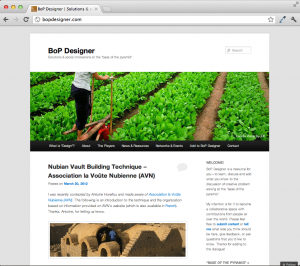 Last year I launched a website and blog called BoP Designer dedicated to “solutions and social innovations at the ‘base of the pyramid.'” The base of the pyramid, or “BoP,” is a term referring to the billions of people in the world living on less than a few dollars per day. Economist C.K. Prahalad used the term in his book, The Fortune at the Bottom of the Pyramid, discussing the benefits of treating this massive population as a huge, untapped market of customers instead of as charity cases. For BoP Designer, I refer to the BoP as the people in developing, low-income and underserved communities around the world where basic needs are high but often unmet and resources are low. Challenges include poverty, food, water, shelter, sanitation, safety, health, education and livelihoods. My goal is for BoP Designer to be a collection of resources, stories, knowledge and links about the field in the hopes of helping, empowering and inspiring designers and others to use design practices create solutions to their own challenges.
Last year I launched a website and blog called BoP Designer dedicated to “solutions and social innovations at the ‘base of the pyramid.'” The base of the pyramid, or “BoP,” is a term referring to the billions of people in the world living on less than a few dollars per day. Economist C.K. Prahalad used the term in his book, The Fortune at the Bottom of the Pyramid, discussing the benefits of treating this massive population as a huge, untapped market of customers instead of as charity cases. For BoP Designer, I refer to the BoP as the people in developing, low-income and underserved communities around the world where basic needs are high but often unmet and resources are low. Challenges include poverty, food, water, shelter, sanitation, safety, health, education and livelihoods. My goal is for BoP Designer to be a collection of resources, stories, knowledge and links about the field in the hopes of helping, empowering and inspiring designers and others to use design practices create solutions to their own challenges.
I define “design” in general as creative problem solving, thanks largely to Roland Young at Art Center, and I’ve spent most of my career since graduation dedicated to creating social and environmental impact, using my skills as a designer to bring more to the table than just communications, but to get my hands on creating and improving products, services, systems and organizations as a whole. I’ve found a lot of opportunity to do that especially with smaller, dynamic, entrepreneurial-type ventures that require everyone to do much more than their job descriptions ask of them to make an idea a success. I’ve been a designer and an implementer, a project manager, a researcher and a facilitator, and I think the more one knows about all the steps of the process from idea to adoption, especially first hand, the more complete and valuable a designer can be.
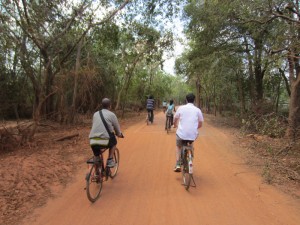 Last August, I came to the end of a contract doing some CSR consulting and faced another the opportunity to either try to drum up more business doing more of the same, or follow a different direction. I had had a strong urge to learn more about and dive deeper into the world of development and I was specifically curious about where “design” fits in the whole landscape. I’ve built and managed websites over the last few years, including managing the AshokaTECH blog, and a website seemed like a natural vehicle to organize what I knew and what I didn’t and start contacting people to learn more. I also wanted to make it public in case this information could be helpful to others. Through BoP Designer, I’ve been learning about the current landscape of designers for social impact in general and especially for development, moving heavily into “appropriate technologies”, product development and engineering, but continuing to include all forms of solutions, whether they’re objects, services or systems.
Last August, I came to the end of a contract doing some CSR consulting and faced another the opportunity to either try to drum up more business doing more of the same, or follow a different direction. I had had a strong urge to learn more about and dive deeper into the world of development and I was specifically curious about where “design” fits in the whole landscape. I’ve built and managed websites over the last few years, including managing the AshokaTECH blog, and a website seemed like a natural vehicle to organize what I knew and what I didn’t and start contacting people to learn more. I also wanted to make it public in case this information could be helpful to others. Through BoP Designer, I’ve been learning about the current landscape of designers for social impact in general and especially for development, moving heavily into “appropriate technologies”, product development and engineering, but continuing to include all forms of solutions, whether they’re objects, services or systems.
I love what I’m doing, constantly learning and sharing, meeting amazing and brilliant people in so many different contexts and cultures. I’ve been taking advantage of my location in Dubai, where I moved last year, traveling to Nepal and India so far, visiting designers and development organizations and learning about their work. And I’ve been talking with as many others as I can all around the world by skype and email.
I have a lot of stories, too many to share here, but I’ll start with one and I’d be happy to talk more with anyone who’d like to contact me.
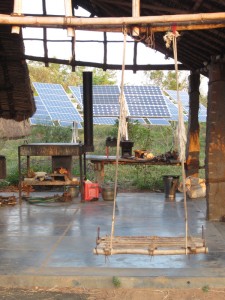
This past January I visited India for the second time in a few months, this time on a short fellowship organized by Quicksand Design (who I highly recommend checking out). I met six other people from various backgrounds in Auroville, a utopian community in southern India near Pondicherry, where we discussed “sustainability” in a very natural setting full of research and development of sustainable technologies and practices. Auroville was founded in 1968 on a spiritual foundation, but not a religious, seeking to create a society in harmony with itself, with nature, and with the community around it. It is a magnet for sustainability experts and practitioners of all kinds, many of whom we were lucky to meet.
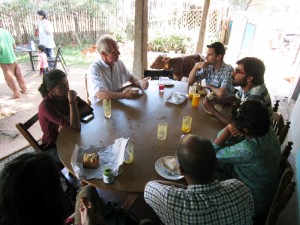 One was Dr. Lucas Dengel, a medical-doctor-turned-organic-farmer who taught us about an organic solution called EM-1, which sounds practically magical in its uses and effects. “EM” stands for “effective microorganisms” and EM-1 is a combination of three of them in a solution that keeps them in a healthy ratio. It was developed by a Japanese agricultural scientist who suffered from the effects of chemical pesticides as a child and developed EM-1 as an organic fertilizer and natural pesticide. In addition to those benefits, Dr. Dengel taught us about others that he had experimented with first hand, including its application in waste management and sanitation, breaking down organic waste in landfills, compost and septic tanks. EM-1, when fed to dairy cows in Auroville and used to wash them and their facilities, cured their cases of hoof rot, radically reduced the smell and number of flies around them, improved their milk production and reduced the amount of times the vet had to visit from once or twice a month to once or twice a year. EM-1 can even be used to clean your kitchen, bathrooms and everywhere, breaking down accumulated dirt and sanitizing surfaces. Testing on human beings has been limited, but many around the world are playing with the possibilities. The potential for this stuff is amazing, learned another lesson on the importance of microorganisms to a healthy ecosystem.
One was Dr. Lucas Dengel, a medical-doctor-turned-organic-farmer who taught us about an organic solution called EM-1, which sounds practically magical in its uses and effects. “EM” stands for “effective microorganisms” and EM-1 is a combination of three of them in a solution that keeps them in a healthy ratio. It was developed by a Japanese agricultural scientist who suffered from the effects of chemical pesticides as a child and developed EM-1 as an organic fertilizer and natural pesticide. In addition to those benefits, Dr. Dengel taught us about others that he had experimented with first hand, including its application in waste management and sanitation, breaking down organic waste in landfills, compost and septic tanks. EM-1, when fed to dairy cows in Auroville and used to wash them and their facilities, cured their cases of hoof rot, radically reduced the smell and number of flies around them, improved their milk production and reduced the amount of times the vet had to visit from once or twice a month to once or twice a year. EM-1 can even be used to clean your kitchen, bathrooms and everywhere, breaking down accumulated dirt and sanitizing surfaces. Testing on human beings has been limited, but many around the world are playing with the possibilities. The potential for this stuff is amazing, learned another lesson on the importance of microorganisms to a healthy ecosystem.
 Another was Dr. Mouhsine Serrar, an engineer and the founder of Prakti Designs. Dr. Serrar develops high efficiency cook stoves that require less fuel and reduce the amount of smoke released, helping to address issues of health, deforestation and income, saving people time collecting cooking fuel, money needed to buy it and health risks due to smoke inhalation, which primarily affects women. Prakti models can burn wood, charcoal or briquettes made from compressed paper and agricultural waste, and they operate so far in India, Nepal and Haiti. There are a lot of cookstoves being developed around the world but Prakti continues to test at or near the top. The field of efficient cookstoves is complex, juggling a mix of technological, human, cultural and economic factors. It’s developing rapidly with increasing interest and I’m really curious to see how it all continues to unfold.
Another was Dr. Mouhsine Serrar, an engineer and the founder of Prakti Designs. Dr. Serrar develops high efficiency cook stoves that require less fuel and reduce the amount of smoke released, helping to address issues of health, deforestation and income, saving people time collecting cooking fuel, money needed to buy it and health risks due to smoke inhalation, which primarily affects women. Prakti models can burn wood, charcoal or briquettes made from compressed paper and agricultural waste, and they operate so far in India, Nepal and Haiti. There are a lot of cookstoves being developed around the world but Prakti continues to test at or near the top. The field of efficient cookstoves is complex, juggling a mix of technological, human, cultural and economic factors. It’s developing rapidly with increasing interest and I’m really curious to see how it all continues to unfold.
A third person we had the opportunity to meet is Jorge Ayarza who founded MinVayu, developing small-scale wind turbines from accessible materials to poor and rural communities. The turbines use carved wooden blades and a tail on a frame that’s relatively easy to weld. It uses a modified car wheel at the center and a series of magnets and coiled wire cast in resin to create a charge at it rotates. When we met Jorge, he was training a couple of Nepalese men on how to build them so they could take the knowledge back with them to apply in Nepal.
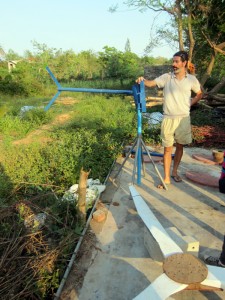 For all we learned about sustainable technologies, Auroville is a grand experiment in society, sustainability and human nature itself, facing lots of obstacles and challenges. The discussions we had with the people we met and among the seven of us were deep and engaging and we had a lot of fun. After Auroville, we traveled north to Delhi for the UnBox Festival for three days of presentations, performances and events revolving around design and creativity in all contexts, also organized by Quicksand Design. It was a very cool, high-quality event that gave us the opportunity to mingle with lots of other designers and experts in so many fields. After the festival I stayed a few extra days to get to know the Quicksand team a little better. They’re becoming a go-to agency for social innovation design in India, with projects funded by the Gates Foundation among others, and are expanding their social impact practice.
For all we learned about sustainable technologies, Auroville is a grand experiment in society, sustainability and human nature itself, facing lots of obstacles and challenges. The discussions we had with the people we met and among the seven of us were deep and engaging and we had a lot of fun. After Auroville, we traveled north to Delhi for the UnBox Festival for three days of presentations, performances and events revolving around design and creativity in all contexts, also organized by Quicksand Design. It was a very cool, high-quality event that gave us the opportunity to mingle with lots of other designers and experts in so many fields. After the festival I stayed a few extra days to get to know the Quicksand team a little better. They’re becoming a go-to agency for social innovation design in India, with projects funded by the Gates Foundation among others, and are expanding their social impact practice.
As I look ahead, I’m pursuing two directions: One, looking for my next job or project in this field of design and development, helping to create solutions to issues in the communities themselves. I’d specifically like to gain more experience in design research, which I’m increasingly more convinced is an invaluable tool and key to any idea’s chances for success. And I’d love to get more hands-on with fabrication processes. The other is continuing to grow BoP Designer to its larger potential, adding team members and more contributors, increasing its content and thinking about how it could add maximum value to the conversation and to the spread of this kind knowledge. If anyone has any leads, opportunities or contributions in either direction, please feel free to contact me. And if I can be of help or if you’d just like to chat more about this subject, I’m always happy to meet new people and like minds. Thanks, and keep up the good work, whatever you’re working on.
